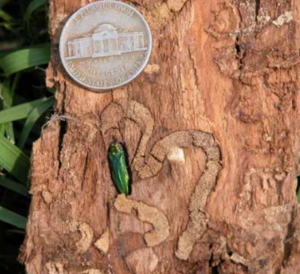
Cam Gordon
BY CAM GORDON
For over a decade, green insects called emerald ash borers (EAB) have been killing ash trees throughout Minneapolis. This fall the City Council appears ready to shift its policy in favor of using pesticides to combat the tree infestations – and it is mostly for financial reasons.
“This was brought to our attention by many of our constituents who were getting bills from MPRB [Minneapolis Park and Recreation Board] for upward of $7,000 per tree with some homeowners having multiple trees that would need to be removed,” said Bethany Turnwall, senior policy aide for the Ward 5 office of Council Member Jeremiah Ellison, who has been spearheading the effort in City Hall. “These steep and unexpected bills are causing major burdens to homeowners who cannot afford paying in full, making partial payments or having it assessed to their property, causing instability in people’s housing.”
“This proposed resolution is being crafted for the benefit of a few private property landowners,” said Ralph Sievert, MPRB Director of Forestry. “There is a misbelief that property owners can save their heavily infested ash trees by treating them. These few property owners believe with treatment they can avoid removals costs and therefore not have the costs assessed to their property.”
When faced with the problem over a decade ago, the park board chose not to use insecticides. Instead, they developed a removal and replacement plan that was completed in 2022 and removed roughly 40,000 ash trees on public property over an eight-year period and replaced them with a diverse mix of other trees.
While the insecticides are legal by state law and private property owners have used them, the city and park board have not, and the city was on record urging “residents to protect the city’s water, flora, fauna and human health during the emerald ash borer infestation by refraining from applying insecticides to trees on private property.”
I was a Minneapolis City Council member in 2009 when emerald ash borer was discovered in the Twin Cities. In the months that followed, insecticide companies began promoting products. They lobbied the city to purchase and use their insecticides. They attended neighborhood meetings to market their products. Others pushed back with concerns about the use of the chemicals which included neonicotinoids that also kill pollinating insects like bees.
In response, Council Member Elizabeth Glidden and I authored, and saw passed, an emerald ash tree resolution (2010-268) urging residents not to use the insecticide.

Emerald ash borer and an ash tree showing the damage.
Russ Henry, owner of Minnehaha Falls Landscaping and a former cochair of the Minneapolis Parks Pesticide Advisory Committee, was part of the effort to reduce the use of insecticides in 2010.
“What the companies providing the treatments don’t want to tell us is that the systemic insecticides they are injecting into ash trees could kill not just the EAB, but more than 280 native insect species that eat from ash trees,” wrote Henry last September in Northern Gardener magazine.
“This new resolution would undo Resolution 2010R-268 which discourages the use of insecticides on ash trees,” said Sievert. “Instead, the use of insecticides would be recommended and encouraged. This could have a negative impact on pollinating insects that visit treated ash trees.”
Recently, $8 million in federal funding was approved to help homeowners remove trees but the program has yet to start. Often, said Turnwall, there are “financial hardships on homeowners which currently are hitting low-income, BIPOC homeowners the most.” It is unclear if any of those funds might be used to cover the costs of insecticide treatments as well as tree removal.
The 2010 resolution, Turnwall said, “was being used by the park board as the reason they did not educate homeowners on treatment options and were going directly to condemning and removing trees while fronting the bill to homeowners.”
When a tree is identified as infected, MPRB marks the trees and notifies property owners that they have 60 days to remove the tree. They can remove it themselves, hire a contractor or have the MPRB contract for the tree removal. If the property owner doesn’t remove it by the deadline or chooses to have it removed by the MPRB, they can pay for it in full at that time, make partial payments, or have the unpaid balance levied as a special assessment against their property over a period of five, 10 or 20 years.
“We the community and current homeowners inherited the problem of the emerald ash borer, including grieving and managing the tragic loss of substantial tree canopy, accompanied by the financial and health burdens to individuals and the public,” said Chesney Engquist, former co-chair of the Minneapolis Parks Pesticide Advisory Committee. “Injecting or otherwise treating standing ash trees with insecticides is a disservice that wrongfully passes these burdens on to the next generation – and potentially increases costs to the same homeowner when the tree finally succumbs and must be removed even after some years of insecticide use.”
“An extra thing to be aware of is that private companies will treat a tree even though it has little likelihood of being successful,” said Sievert.
“The insecticides used to treat EAB in ash trees is systemic, meaning it is transferred into every part of the plant after treatment. There are native insects that eat from every part of the plant, and all of these are likely going to be killed,” said Henry.
“The City’s position with this resolution is not to promote the use of insecticide treatment for ash trees but to clarify that residents have the option of using insecticides for treatment of emerald ash borer,” said Kelly Muellman of the Minneapolis Health Department. “Based on experts in the field of forestry in Minnesota, it is not likely that many ash trees in Minneapolis would be candidates for insecticide treatment due to the length of time the ash borer has been present.”
“We also care deeply about pollinators and would prefer that an ash tree be removed and replaced with another shade tree. At the same time, we want homeowners to have their options spelled out for them to make informed decisions,” said Muellman. The resolution recommends the use of non-neonicotinoid, trunk-injected pesticides.
People are not just concerned about the pollinators. According to Henry, when a poisoned insect is eaten, the poison is transferred up to the larger animal who it may also harm or kill.
Muellman said that “the reason that the city is passing this resolution is to give MPRB the permission to make homeowners aware of their options to treat if their tree might be a viable candidate,” but it is unclear what, if anything, the park board might do with that permission. Even if they do not change any practices, some worry about the message a change like this in city policy might send to property owners and how insecticide companies might use it.
“Every spring when we walk outside, we breathe in ash tree pollen. Every fall as leaves are crunched, we breathe in ash leaf dust. Both the pollen and leaves contain the insecticide after treatment,” said Henry. “There is no science showing the safety or danger of people breathing in ash pollen and foliage laden with insecticide.”
“The precautionary principle (abstaining from suspect toxic chemical use) must be applied to EAB management so that we do not risk untold damage to the ecosystem and our community’s health,” said Engquist. “I would implore the MPRB and City Council to find a way to support low-income homeowners who cannot afford the removal of infested and susceptible trees, so that community members are not under threat of unmanageable tax liens – and so that we address EAB without inflicting unnecessary harm on our children and grandchildren by adding to the load of poisonous environmental toxins they must already endure.”
On Oct. 25, the council’s Public Health and Safety Committee voted to support the revised proposal with Council Members Elliot Payne, Robin Wonsley, Michael Rainville, LaTrisha Vetaw and Jeremiah Ellison voting in favor of it and Linea Palmisano abstaining. It is likely to be approved by the full council in November.






















